The Impact of Aerosols on Satellite Radiance Data Assimilation Using NCEP Global Data Assimilation System
Abstract
1. Introduction
2. Datasets and Methods
2.1. NCEP Global Data Assimilation System
- First-guesses: short-range deterministic forecasts (3, 6, 9 h)
- Ensemble background error covariance: 80-member ensemble forecasts (3, 6, 9 h)
- The available observations within a 6-h (−3 to +3 h) window
- Prescribed static background error covariance and observation error covariance
2.2. CRTM
2.3. NGAC v2
2.4. Experimental Design
2.5. Observational Dataset
2.6. Statistical Analysis
3. Results
3.1. Brightness Temperature
3.2. First-Guess Departure
3.3. Bias Correction and Quality Control
3.4. Use of Observation
3.5. Temperature Analysis
4. Discussion and Conclusions
Author Contributions
Funding
Institutional Review Board Statement
Informed Consent Statement
Data Availability Statement
Acknowledgments
Conflicts of Interest
References
- Mitchell, J.M., Jr. The Effect of Atmospheric Aerosols on Climate with Special Reference to Temperature near the Earth’s Surface. J. Appl. Meteorol. 1971, 10, 703–714. [Google Scholar] [CrossRef]
- Twomey, S. Pollution and the Planetary Albedo. Atmos. Environ. 1974, 8, 1251–1256. [Google Scholar] [CrossRef]
- Twomey, S. The Influence of Pollution on the Shortwave Albedo of Clouds. J. Atmos. Sci. 1977, 34, 1149–1152. [Google Scholar] [CrossRef]
- Albrecht, B.A. Aerosols, Cloud Microphysics, and Fractional Cloudiness. Science 1989, 245, 1227–1230. [Google Scholar] [CrossRef] [PubMed]
- Jones, A.; Roberts, D.L.; Slingo, A. A climate model study of indirect radiative forcing by anthropogenic sulphate aerosols. Nature 1994, 370, 450–453. [Google Scholar] [CrossRef]
- Ackerman, A.S.; Toon, O.B.; Stevens, D.E.; Heymsfield, A.J.; Ramanathan, V.; Welton, E.J. Reduction of Tropical Cloudiness by Soot. Science 2000, 288, 1042–1047. [Google Scholar] [CrossRef]
- Lohmann, U.; Feichter, J.; Penner, J.; Leaitch, R. Indirect effect of sulfate and carbonaceous aerosols: A mechanistic treatment. J. Geophys. Res. Atmos. 2000, 105, 12193–12206. [Google Scholar] [CrossRef]
- Tompkins, A.M.; Cardinali, C.; Morcrette, J.-J.; Rodwell, M.J. Influence of aerosol climatology on forecasts of the African Easterly Jet. Geophys. Res. Lett. 2005, 32. [Google Scholar] [CrossRef]
- Pérez, C.; Nickovic, S.; Pejanovic, G.; Baldasano, J.M.; Özsoy, E. Interactive dust-radiation modeling: A step to improve weather forecasts. J. Geophys. Res. 2006, 111. [Google Scholar] [CrossRef]
- Rodwell, M.J.; Jung, T. Understanding the local and global impacts of model physics changes: An aerosol example. Q. J. R. Meteorol. Soc. 2008, 134, 1479–1497. [Google Scholar] [CrossRef]
- Mulcahy, J.P.; Walters, D.N.; Bellouin, N.; Milton, S.F. Impacts of increasing the aerosol complexity in the Met Office global numerical weather prediction model. Atmos. Chem. Phys. 2014, 14, 4749–4778. [Google Scholar] [CrossRef]
- Bozzo, A.; Remy, S.; Benedetti, A.; Flemming, J.; Bechtold, P.; Rodwell, M.J.; Morcrette, J.-J. Implementation of a CAMS-Based Aerosol Climatology in the IFS; ECMWF Tech. Memo; European Centre for Medium Range Weather Forecasts: Reading, UK, 2017; Volume 801.
- Nowottnick, E.P.; Colarco, P.R.; Braun, S.A.; Barahona, D.O.; da Silva, A.; Hlavka, D.L.; McGill, M.J.; Spackman, J.R. Dust Impacts on the 2012 Hurricane Nadine Track during the NASA HS3 Field Campaign. J. Atmos. Sci. 2018, 75, 2473–2489. [Google Scholar] [CrossRef] [PubMed]
- Highwood, E.J.; Haywood, J.M.; Silverstone, M.D.; Newman, S.M.; Taylor, J.P. Radiative Properties and Direct Effect of Saharan Dust Measured by the C-130 Aircraft during Saharan Dust Experiment (SHADE): 2. Terrestrial Spectrum. J. Geophys. Res. 2003, 108, 8578. [Google Scholar] [CrossRef]
- Köhler, C.H.; Trautmann, T.; Lindermeir, E.; Vreeling, W.; Lieke, K.; Kandler, K.; Weinzierl, B.; Groß, S.; Tesche, M.; Wendisch, M. Thermal IR Radiative Properties of Mixed Mineral Dust and Biomass Aerosol during SAMUM-2. Tellus B Chem. Phys. Meteorol. 2011, 63, 751–769. [Google Scholar] [CrossRef]
- Sokolik, I.N. The spectral radiative signature of wind-blown mineral dust: Implications for remote sensing in the thermal IR region. Geophys. Res. Lett. 2002, 29, 7-1–7-4. [Google Scholar] [CrossRef]
- Pierangelo, C.; Chedin, A.; Heilliette, S.; Jacquinet-Husson, N.; Armante, R. Dust altitude and infrared optical depth from AIRS. Atmos. Chem. Phys. 2004, 4, 1813–1822. [Google Scholar] [CrossRef]
- Matricardi, M. The Inclusion of Aerosols and Clouds in RTIASI, the ECMWF Fast Radiative Transfer Model for the Infrared Atmospheric Sounding Interferometer; ECMWF Tech. Memo; European Centre for Medium Range Weather Forecasts: Reading, UK, 2005; Volume 474.
- Merchant, C.J.; Embury, O.; Le Borgne, P.; Bellec, B. Saharan dust in nighttime thermal imagery: Detection and reduction of related biases in retrieved sea surface temperature. Remote Sens. Environ. 2006, 104, 15–30. [Google Scholar] [CrossRef]
- Liu, Q.; Han, Y.; van Delst, P.; Weng, F. Modeling aerosol radiance for NCEP data assimilation. In Fourier Transform Spectroscopy/Hyperspectral Imaging and Sounding of the Environment; HThA5; Optical Society of America: Washington, DC, USA, 2007. [Google Scholar] [CrossRef]
- Chen, Y.; Han, Y.; Weng, F. Comparison of two transmittance algorithms in the community radiative transfer model: Application to AVHRR. J. Geophys. Res. Atmos. 2012, 117. [Google Scholar] [CrossRef]
- Quan, X.; Huang, H.-L.; Zhang, L.; Weisz, E.; Cao, X. Sensitive detection of aerosol effect on simulated IASI spectral radiance. J. Quant. Spectrosc. Radiat. Transf. 2013, 122, 214–232. [Google Scholar] [CrossRef]
- Divakarla, M.; Barnet, C.; Goldberg, M.; Gu, D.; Liu, X.; Xiong, X.; Kizer, S.; Guo, G.; Wilson, M.; Maddy, E.; et al. Evaluation of CrIMSS operational products using in-situ measurements, model analysis fields, and retrieval products from heritage algorithms. In Proceedings of the 2012 IEEE International Geoscience and Remote Sensing Symposium, Munich, Germany, 22–27 July 2012; pp. 1046–1049. [Google Scholar]
- Letertre-Danczak, J. The Use of Geostationary Radiance Observations at ECMWF and Aerosol Detection for Hyper-Spectral Infrared Sounders: 1st and 2nd Years Report; EUMETSAT/ECMWF Fellowship Programme Research Reports; European Centre for Medium Range Weather Forecasts: Reading, UK, 2016; Volume 40.
- Geer, A.J.; Migliorini, S.; Matricardi, M. All-sky assimilation of infrared radiances sensitive to mid- and upper-tropospheric moisture and cloud. Atmos. Meas. Tech. Discuss. 2019, 12, 4903–4929. [Google Scholar] [CrossRef]
- Weaver, C.J.; Joiner, J.; Ginoux, P. Mineral aerosol contamination of TIROS Operational Vertical Sounder (TOVS) temperature and moisture retrievals. J. Geophys. Res. 2003, 108. [Google Scholar] [CrossRef]
- Kim, J.; Akella, S.; da Silva, A.M.; Todling, R.; McCarty, W. Preliminary Evaluation of Influence of Aerosols on the Simulation of Brightness Temperature in the NASA’s Goddard Earth Observing System Atmospheric Data Assimilation System; Tech. Rep. Ser. Glob. Model. Data Assim.; Goddard Space Flight Center, National Aeronautics and Space Administration: Greenbelt, MD, USA, 2018.
- Wang, X.; Lei, T. GSI-Based Four-Dimensional Ensemble—Variational (4DEnsVar) Data Assimilation: Formulation and Single-Resolution Experiments with Real Data for NCEP Global Forecast System. Mon. Weather Rev. 2014, 142, 3303–3325. [Google Scholar] [CrossRef]
- Kleist, D.T.; Ide, K. An OSSE-Based Evaluation of Hybrid Variational—Ensemble Data Assimilation for the NCEP GFS. Part II: 4DEnVar and Hybrid Variants. Mon. Weather Rev. 2015, 143, 452–470. [Google Scholar] [CrossRef]
- Lorenc, A.C.; Rawlins, F. Why Does 4D-Var Beat 3D-Var? Q. J. R. Meteorol. Soc. 2005, 131, 3247–3257. [Google Scholar] [CrossRef]
- Weng, F.; Han, Y.; van Delst, P.; Liu, Q.; Kleespies, T.; Yan, B.; Marshall, J.L. JCSDA Community Radiative Transfer Model (CRTM). In Proceedings of the 14th International TOVS Study Conference, BeiJing, China, 25–31 May 2005; p. 6. [Google Scholar]
- Han, Y.; van Delst, P.; Liu, Q.; Weng, F.; Yan, B.; Treadon, R.; Derber, J. JCSDA Community Radiative Transfer Model (CRTM)—Version 1; NOAA Technical Report NESDIS; National Oceanic and Atmospheric Administration National Environmental Satellite, Data, and Information Service: Washington, DC, USA, 2006; Volume 122.
- Derber, J.C.; Wu, W.-S. The Use of TOVS Cloud-Cleared Radiances in the NCEP SSI Analysis System. Mon. Weather Rev. 1998, 126, 2287–2299. [Google Scholar] [CrossRef]
- Zhu, Y.; Derber, J.; Collard, A.; Dee, D.; Treadon, R.; Gayno, G.; Jung, J.A. Enhanced radiance bias correction in the National Centers for Environmental Prediction’s Gridpoint Statistical Interpolation data assimilation system: Radiance Bias Correction in GSI. Q. J. R. Meteorol. Soc. 2014, 140, 1479–1492. [Google Scholar] [CrossRef]
- Liang, D.; Weng, F. Evaluation of the impact of a new quality control method on assimilation of CrIS data in HWRF-GSI. In Proceedings of the 2014 IEEE Geoscience and Remote Sensing Symposium, Quebec City, QC, Canada, 13–18 July 2014; pp. 3778–3781. [Google Scholar]
- Gemmill, W.; Katz, B.; Li, X.; Burroughs, L.D. The Daily Real-Time, Global Sea Surface Temperature—High Resolution Analysis: RTG_SST_HR. Tech. Proc. Bull. 2006, 10, 1–39. [Google Scholar]
- Liu, Q.; Weng, F. Advanced Doubling—Adding Method for Radiative Transfer in Planetary Atmospheres. J. Atmos. Sci. 2006, 63, 3459–3465. [Google Scholar] [CrossRef]
- Ding, S.; Yang, P.; Weng, F.; Liu, Q.; Han, Y.; van Delst, P.; Li, J.; Baum, B. Validation of the Community Radiative Transfer Model. J. Quant. Spectrosc. Radiat. Transf. 2011, 112, 1050–1064. [Google Scholar] [CrossRef]
- Li, J.; Li, Z.; Wang, P.; Schmit, T.J.; Bai, W.; Atlas, R. An Efficient Radiative Transfer Model for Hyperspectral IR Radiance Simulation and Applications under Cloudy-sky Conditions. J. Geophys. Res. Atmos. 2017, 122, 7600–7613. [Google Scholar] [CrossRef]
- Hess, M.; Koepke, P.; Schult, I. Optical Properties of Aerosols and Clouds: The Software Package OPAC. Bull. Am. Meteorol. Soc. 1998, 79, 831–844. [Google Scholar] [CrossRef]
- Liu, Q.; Lu, C.-H. Community Radiative Transfer Model for Air Quality Studies. In Light Scattering Reviews; Kokhanovsky, A., Ed.; Springer Praxis Books; Springer: Berlin/Heidelberg, Germany, 2016; Volume 11, pp. 67–115. [Google Scholar]
- Lu, C.-H.; da Silva, A.; Wang, J.; Moorthi, S.; Chin, M.; Colarco, P.; Tang, Y.; Bhattacharjee, P.S.; Chen, S.-P.; Chuang, H.-Y.; et al. The implementation of NEMS GFS Aerosol Component (NGAC) Version 1.0 for global dust forecasting at NOAA/NCEP. Geosci. Model Dev. 2016, 9, 1905–1919. [Google Scholar] [CrossRef] [PubMed]
- Wang, J.; Bhattacharjee, P.S.; Tallapragada, V.; Lu, C.-H.; Kondragunta, S.; da Silva, A.; Zhang, X.; Chen, S.-P.; Wei, S.-W.; Darmenov, A.S.; et al. The implementation of NEMS GFS Aerosol Component (NGAC) Version 2.0 for global multispecies forecasting at NOAA/NCEP—Part 1: Model descriptions. Geosci. Model Dev. 2018, 11, 2315–2332. [Google Scholar] [CrossRef]
- Zhang, L.; Grell, G.A.; Montuoro, R.; McKeen, S.A.; Bhattacharjee, P.S.; Baker, B.; Henderson, J.; Pan, L.; Frost, G.J.; McQueen, J.; et al. Development of GEFS-Aerosols into NOAAs Unified Forecast System UFS. Geosci. Model Dev. 2020. to be submitted. [Google Scholar]
- Chin, M.; Rood, R.B.; Lin, S.-J.; Müller, J.-F.; Thompson, A.M. Atmospheric sulfur cycle simulated in the global model GOCART: Model description and global properties. J. Geophys. Res. Atmos. 2000, 105, 24671–24687. [Google Scholar] [CrossRef]
- Colarco, P.; da Silva, A.; Chin, M.; Diehl, T. Online simulations of global aerosol distributions in the NASA GEOS-4 model and comparisons to satellite and ground-based aerosol optical depth. J. Geophys. Res. 2010, 115. [Google Scholar] [CrossRef]
- Bhattacharjee, P.S.; Wang, J.; Lu, C.-H.; Tallapragada, V. The implementation of NEMS GFS Aerosol Component (NGAC) Version 2.0 for global multispecies forecasting at NOAA/NCEP—Part 2: Evaluation of aerosol optical thickness. Geosci. Model Dev. 2018, 11, 2333–2351. [Google Scholar] [CrossRef]
- Ota, Y.; Derber, J.C.; Kalnay, E.; Miyoshi, T. Ensemble-Based Observation Impact Estimates Using the NCEP GFS. Tellus A Dyn. Meteorol. Oceanogr. 2013, 65, 20038. [Google Scholar] [CrossRef]
- Groff, D. Assessment of ensemble Forecast sensitivity to Observation (eFsO) Quantities for satellite Radiances Assimilated in the 4DenVar GFs. JCSDA Q. 2017, 54, 1–5. [Google Scholar] [CrossRef]
- Cardinali, C. Forecast Sensitivity Observation Impact with an Observation-Only Based Objective Function. Q. J. R. Meteorol. Soc. 2018, 144, 2089–2098. [Google Scholar] [CrossRef]
- Diniz, F.L.R.; Todling, R. Assessing the Impact of Observations in a Multi-year Reanalysis. Q. J. R. Meteorol. Soc. 2020, 146, 724–747. [Google Scholar] [CrossRef]
- Hilton, F.; Armante, R.; August, T.; Barnet, C.; Bouchard, A.; Camy-Peyret, C.; Capelle, V.; Clarisse, L.; Clerbaux, C.; Coheur, P.-F.; et al. Hyperspectral Earth Observation from IASI: Five Years of Accomplishments. Bull. Am. Meteor. Soc. 2012, 93, 347–370. [Google Scholar] [CrossRef]
- O’Carroll, A.G.; August, T.; Le Borgne, P.; Marsouin, A. The Accuracy of SST Retrievals from Metop-A IASI and AVHRR Using the EUMETSAT OSI-SAF Matchup Dataset. Remote Sens. Environ. 2012, 126, 184–194. [Google Scholar] [CrossRef]
- Le Borgne, P.; Legendre, G.; Marsouin, A.; Péré, S. Operational SST Retrieval from METOP/AVHRR Validation Report, version 2.0; Ocean and Sea-Ice SAF CDOP Report; Météo-France/DP/CMS: Lannion, France, 2008. [Google Scholar]
- August, T.; Klaes, D.; Schlüssel, P.; Hultberg, T.; Crapeau, M.; Arriaga, A.; O’Carroll, A.; Coppens, D.; Munro, R.; Calbet, X. IASI on Metop-A: Operational Level 2 Retrievals after Five Years in Orbit. J. Quant. Spectrosc. Radiat. Transf. 2012, 113, 1340–1371. [Google Scholar] [CrossRef]
- Grogan, D.; Lu, C.-H. Impacts of Aerosols on Meteorological Assimilation: A Case Study for the African Easterly Wave that Developed Hurricane Harvey. JCSDA Q. 2020, 67, 12–18. [Google Scholar] [CrossRef]
- Wei, S.-W.; Collard, A.; Grumbine, R.; Liu, Q.; Lu, C.-H. Impacts of Aerosols on Simulated Brightness Temperature and Analysis Fields. JCSDA Q. 2020, 67, 7–12. [Google Scholar] [CrossRef]
- Otto, S.; Trautmann, T.; Wendisch, M. On Realistic Size Equivalence and Shape of Spheroidal Saharan Mineral Dust Particles Applied in Solar and Thermal Radiative Transfer Calculations. Atmos. Chem. Phys. 2011, 11, 4469–4490. [Google Scholar] [CrossRef]
- Klüser, L.; Di Biagio, C.; Kleiber, P.D.; Formenti, P.; Grassian, V.H. Optical Properties of Non-Spherical Desert Dust Particles in the Terrestrial Infrared—An Asymptotic Approximation Approach. J. Quant. Spectrosc. Radiat. Transf. 2016, 178, 209–223. [Google Scholar] [CrossRef]
- Zhu, Y.; Liu, E.; Mahajan, R.; Thomas, C.; Groff, D.; Van Delst, P.; Collard, A.; Kleist, D.; Treadon, R.; Derber, J.C. All-Sky Microwave Radiance Assimilation in NCEP’s GSI Analysis System. Mon. Weather Rev. 2016, 144, 4709–4735. [Google Scholar] [CrossRef]
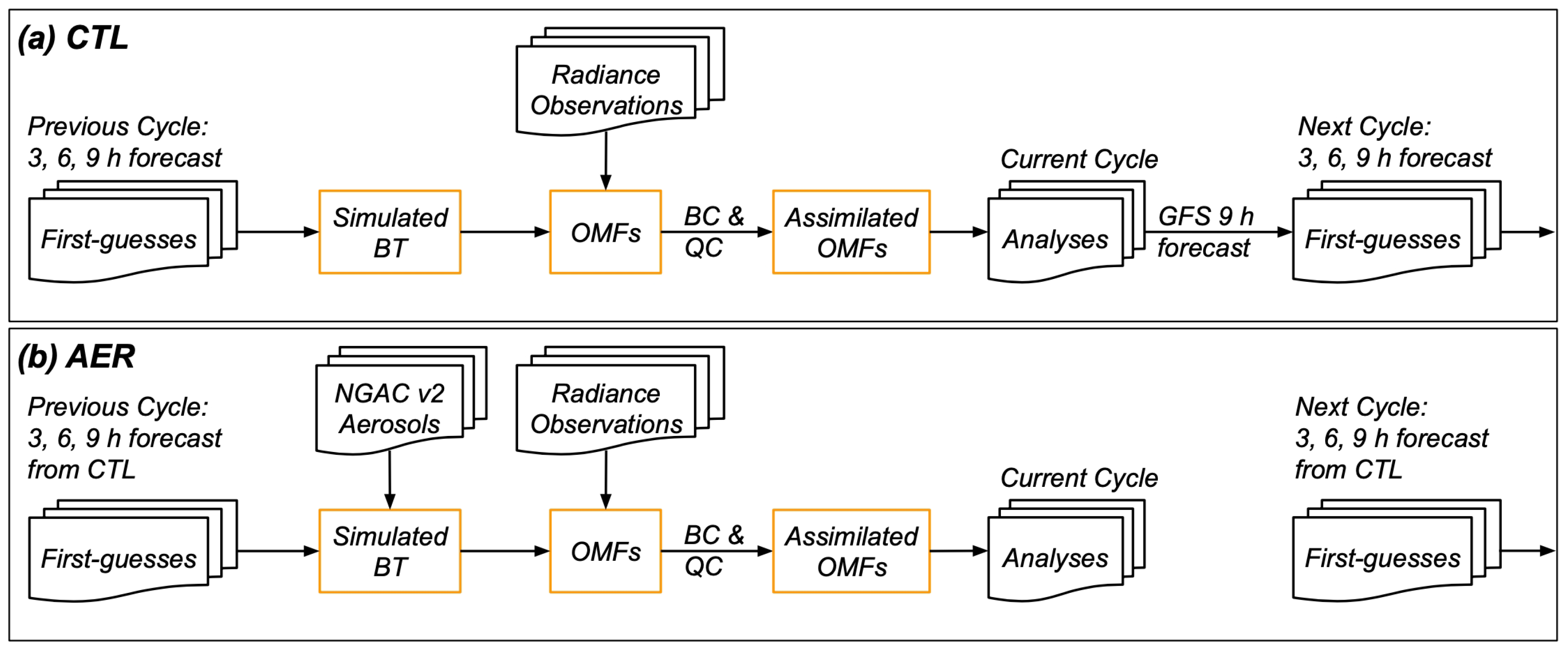
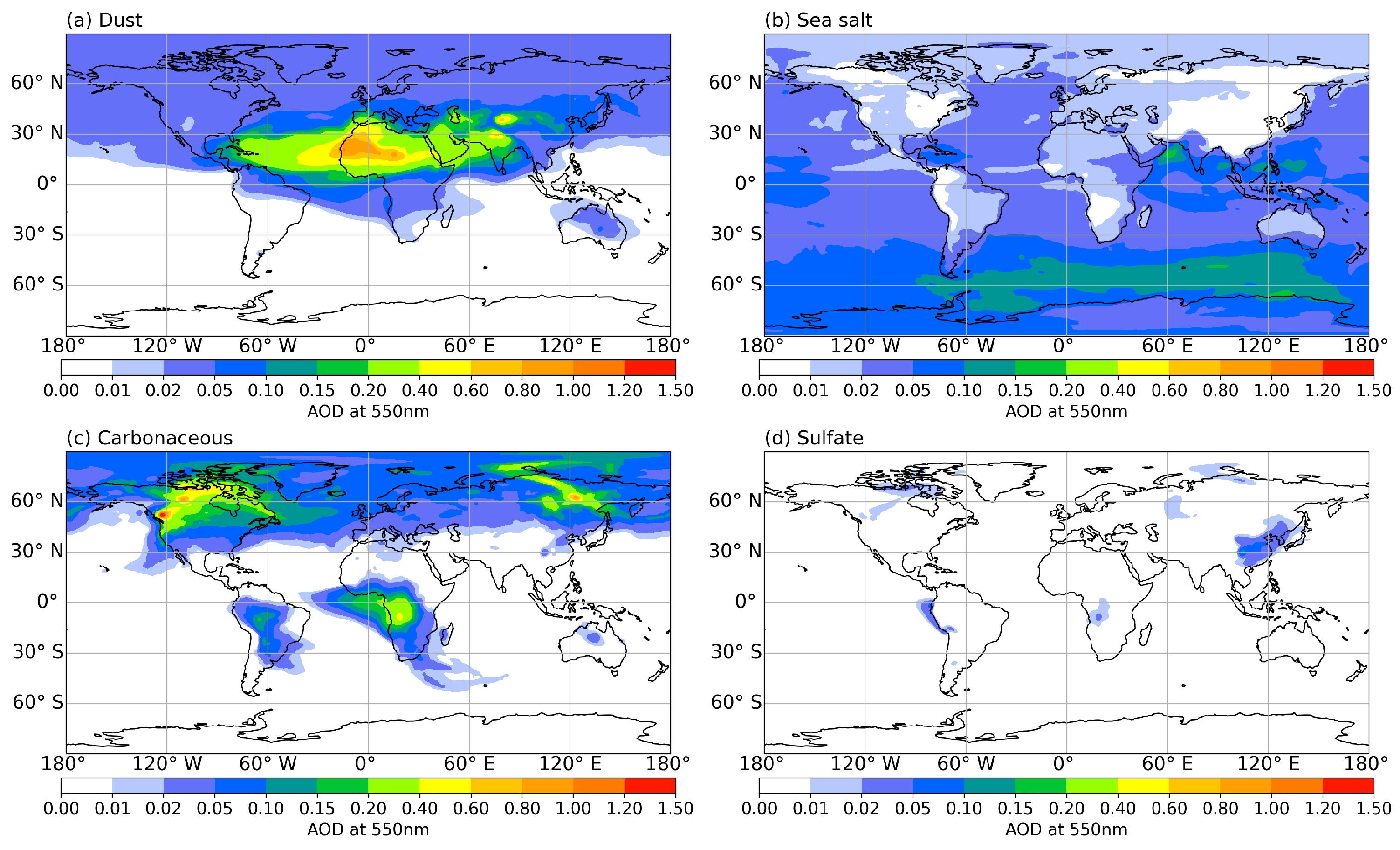
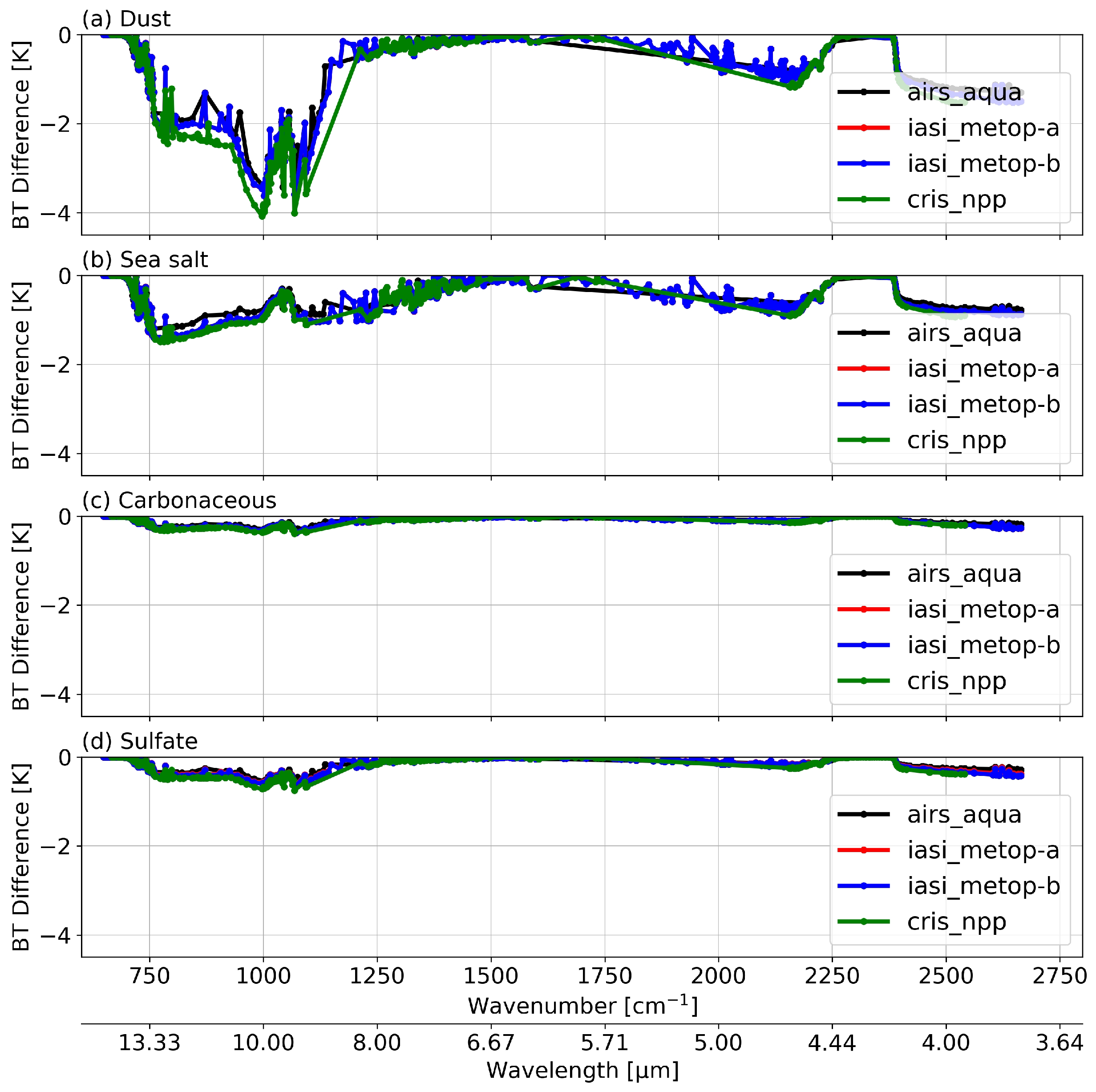
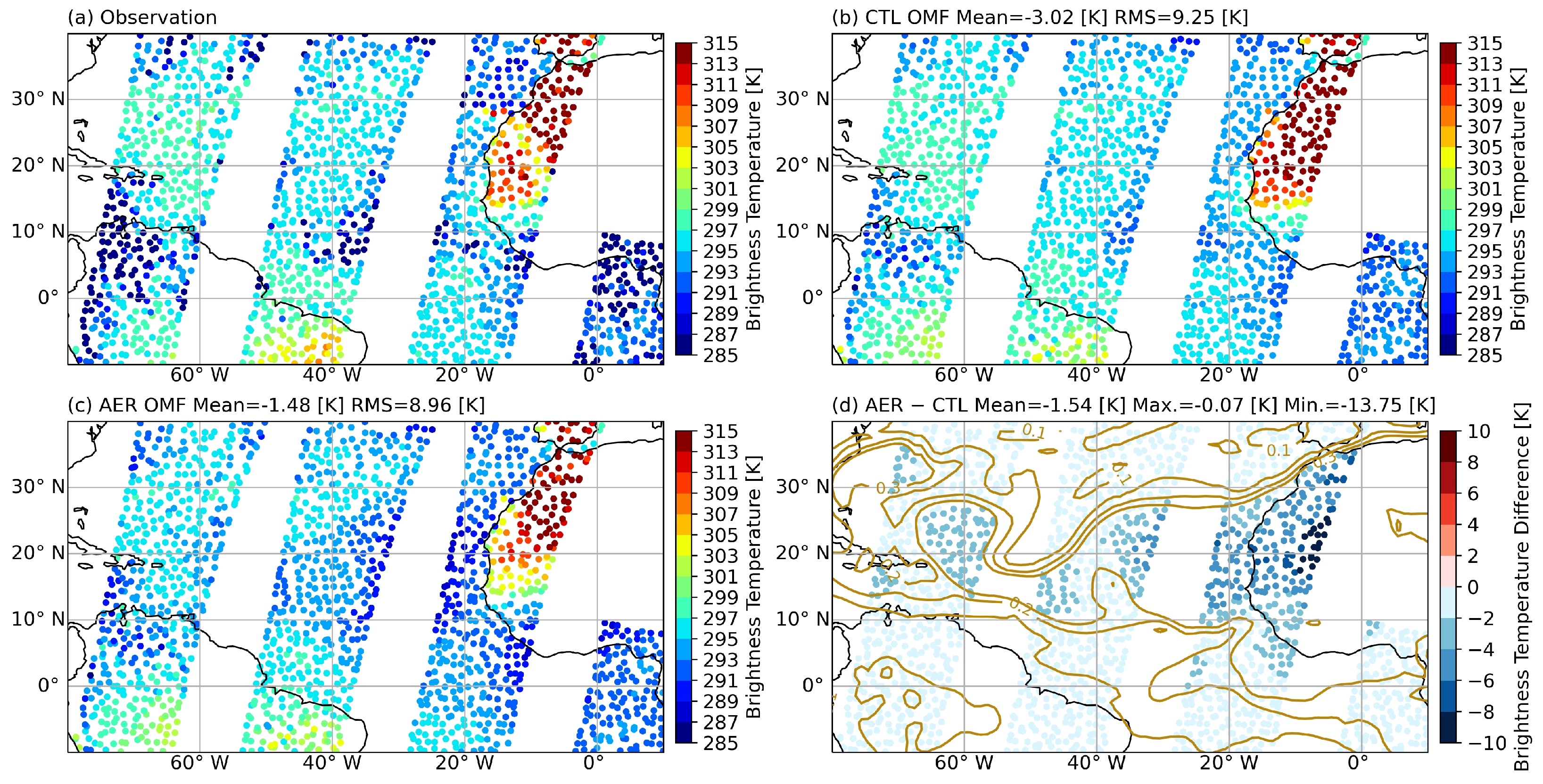
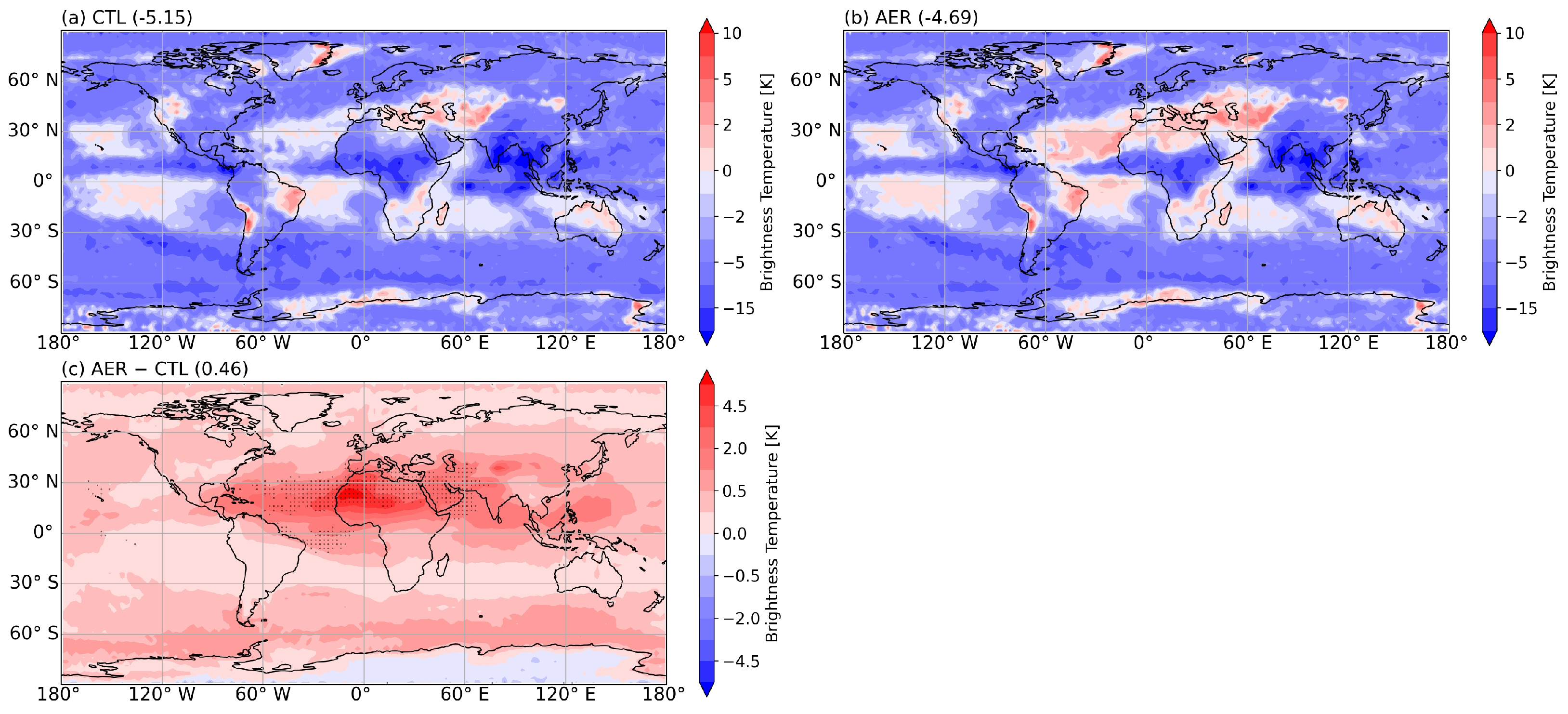
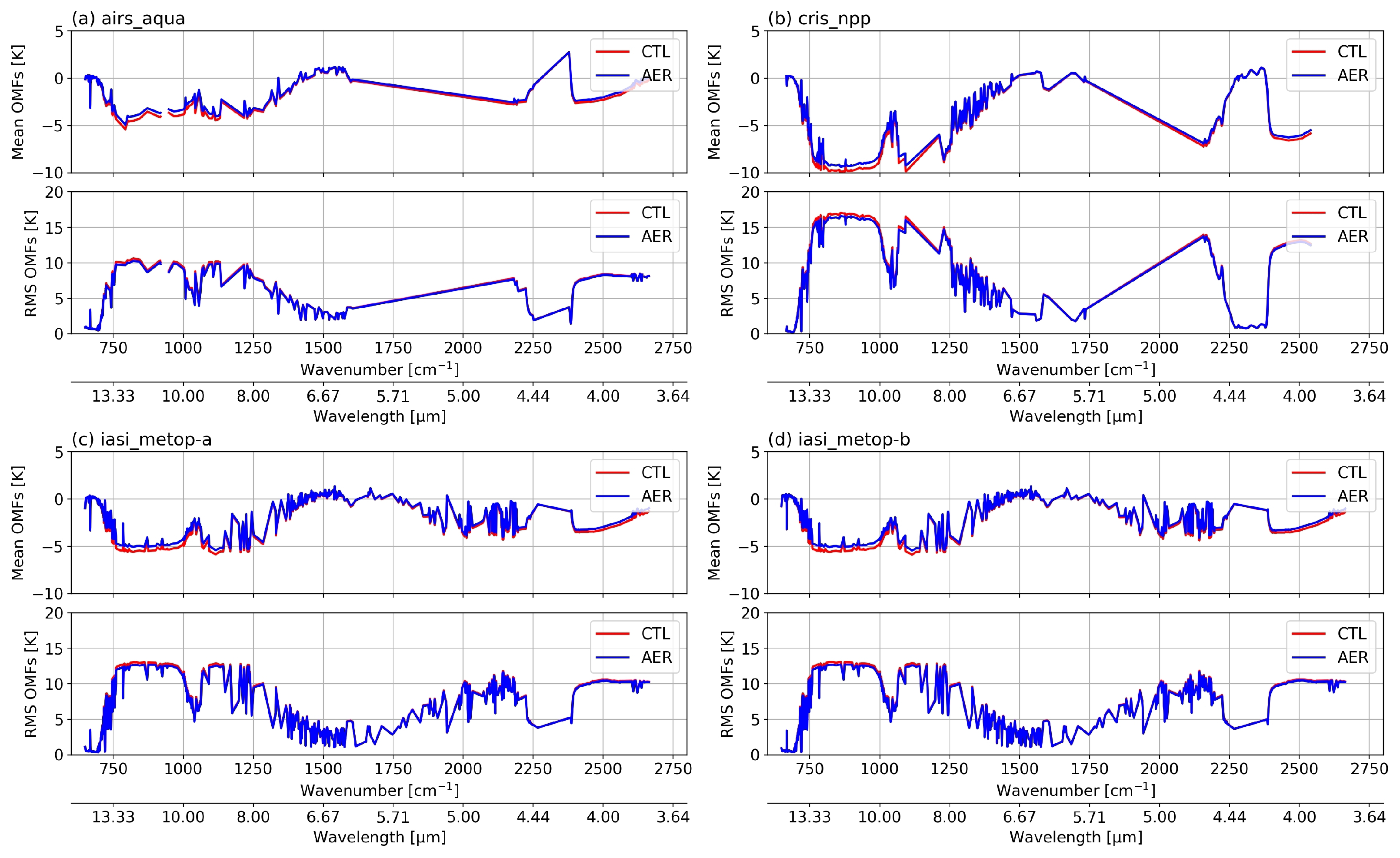
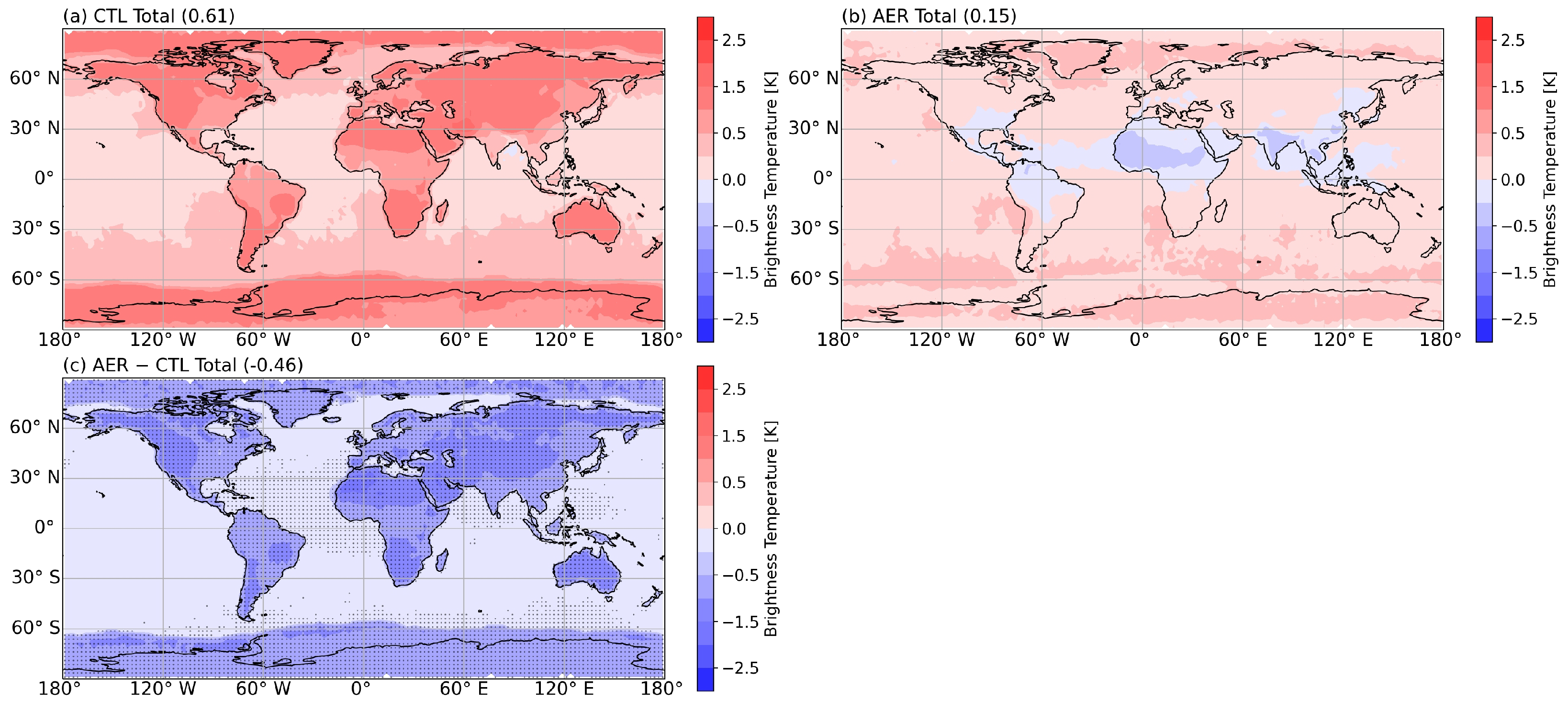


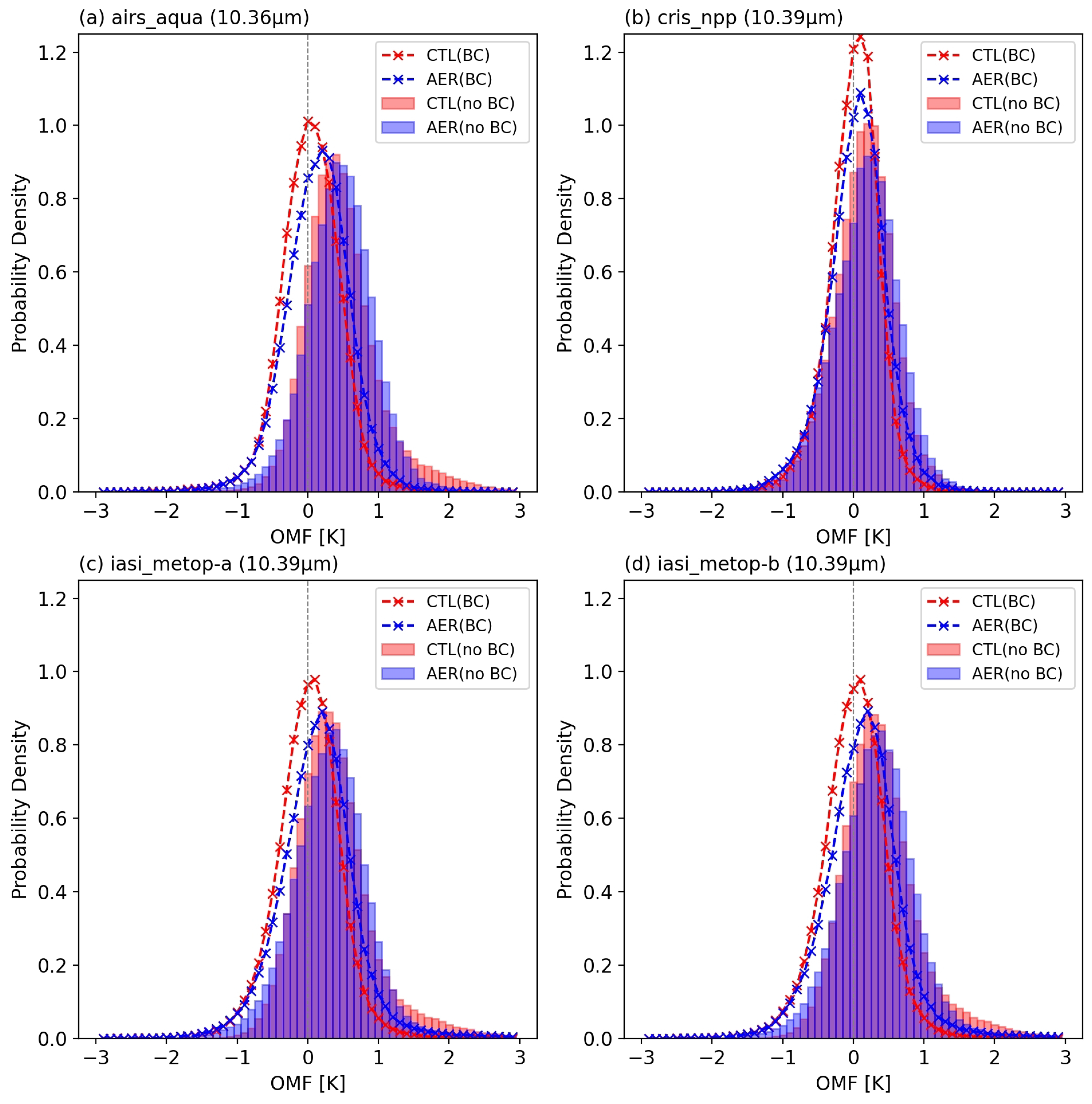
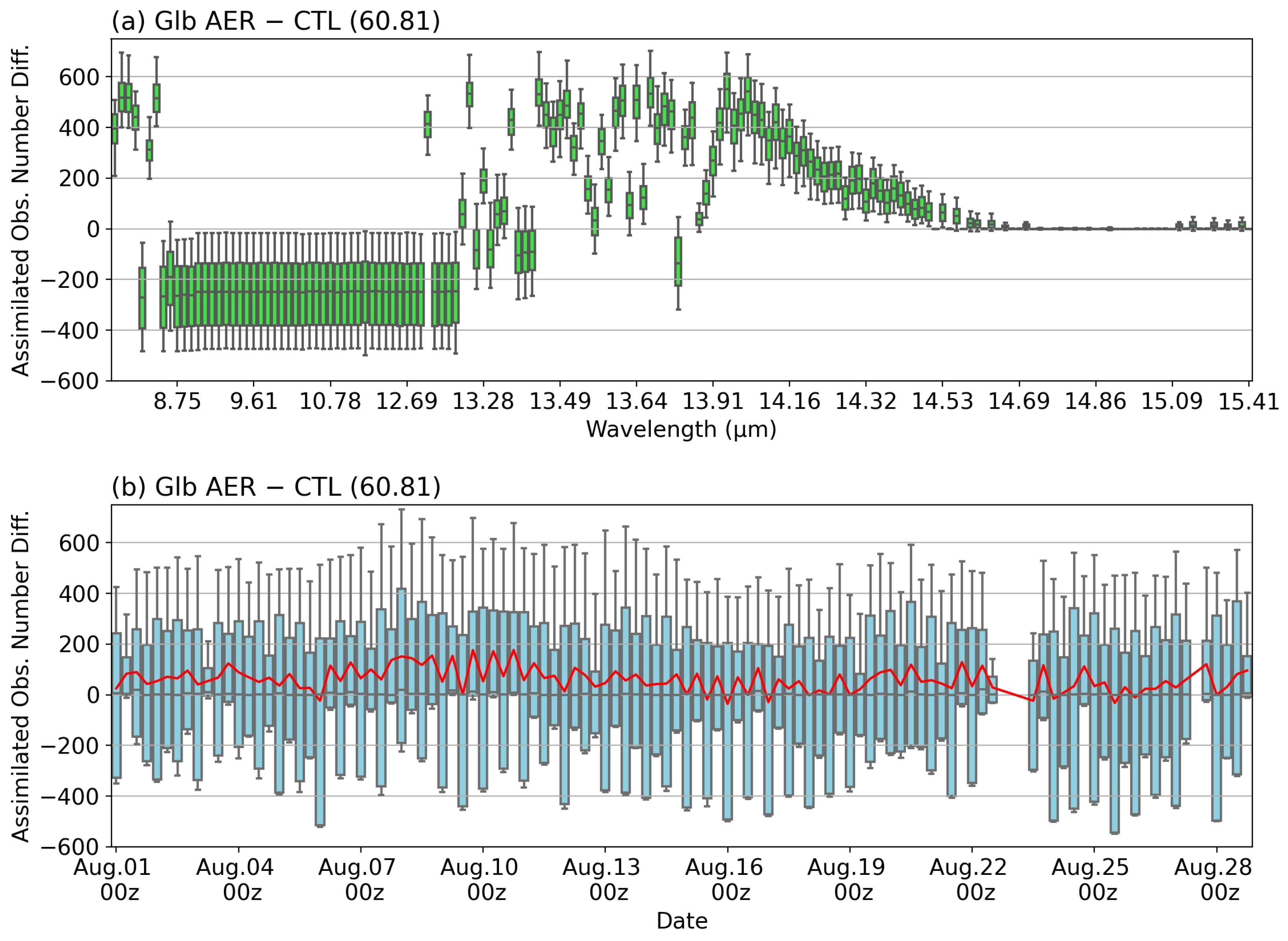
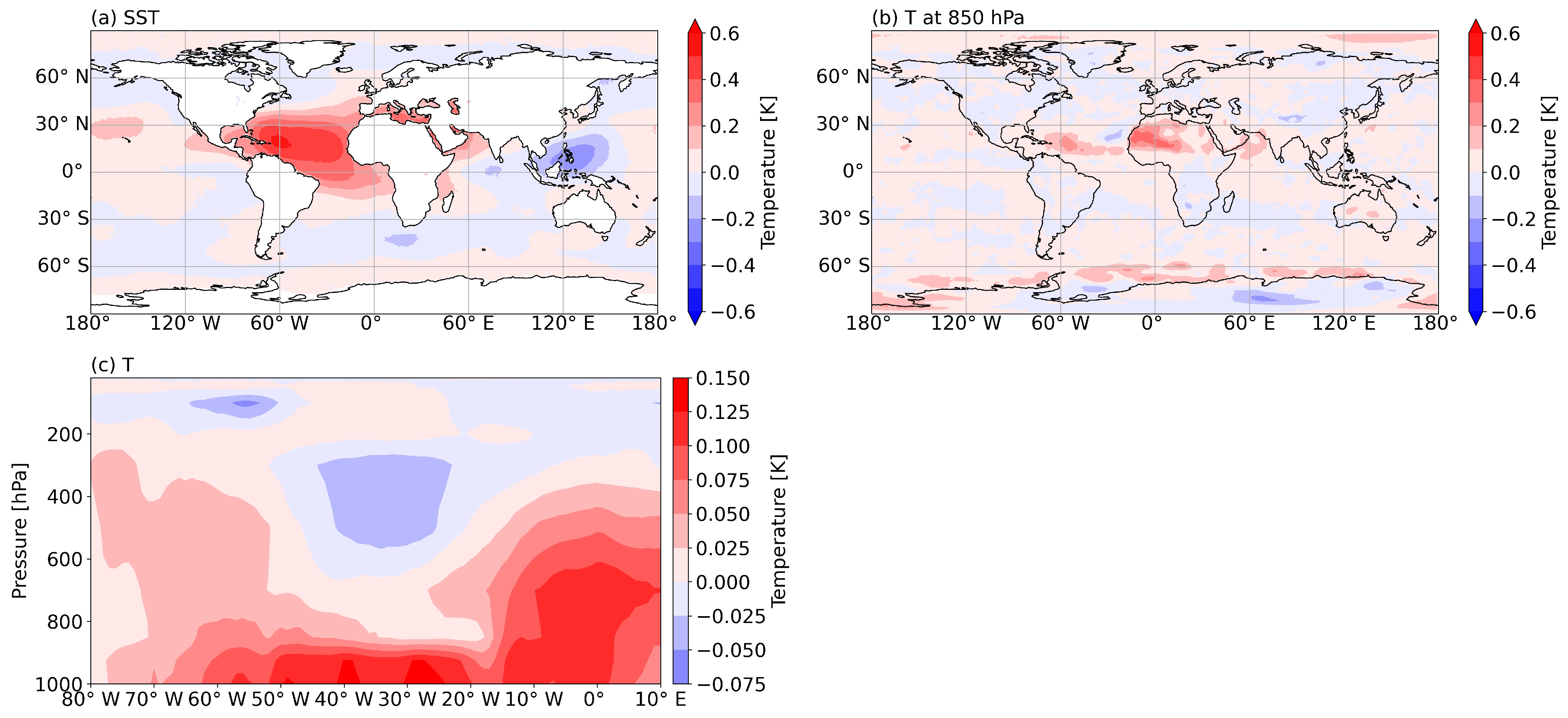
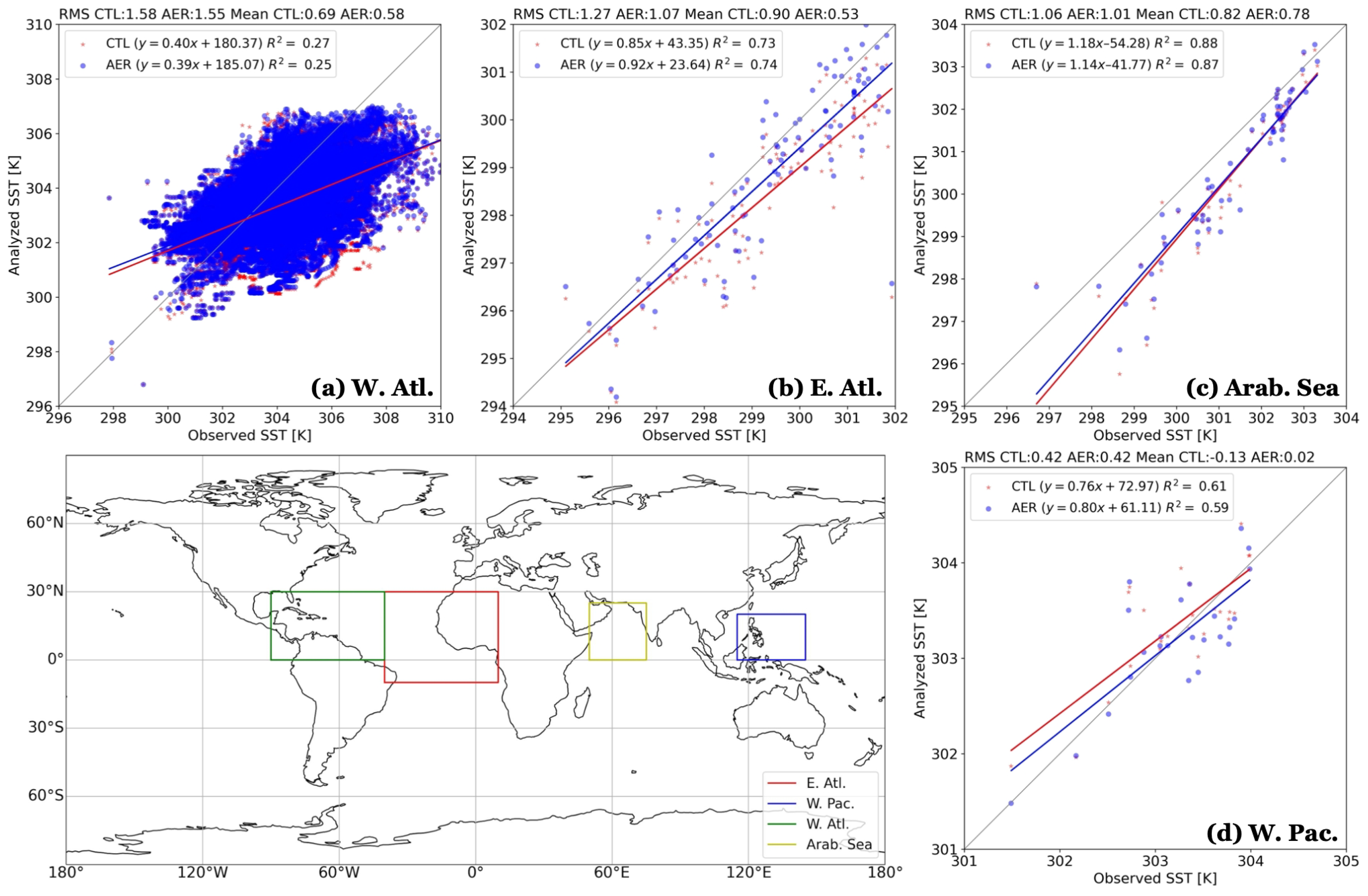
| IR Instrument | Satellite | Assimilated/Subset Channels Number | ECT */Location |
|---|---|---|---|
| Sun-synchronous | |||
| AIRS | Aqua | 117/281 | 13:30 asc |
| AVHRR | MetOp-A | 3/3 | 08:46 desc |
| AVHRR | NOAA-18 | 3/3 | 19:15 asc |
| CrIS | Suomi-NPP | 82/399 | 13:25 asc |
| HIRS4 | MetOp-A | 0/19 | 08:46 desc |
| HIRS4 | MetOp-B | 0/19 | 09:30 desc |
| HIRS4 | NOAA-19 | 0/19 | 15:15 asc |
| IASI | MetOp-A | 164/616 | 08:46 desc |
| IASI | MetOp-B | 164/616 | 09:30 desc |
| Geostationary | |||
| SEVIRI | Meteosat-8 | 0/8 | 41.5° E |
| SEVIRI | Meteosat-10 | 2/8 | 9.5° E |
| SNDRD1 | GOES-15 | 15/18 | 128° W |
| SNDRD2 | GOES-15 | 15/18 | 128° W |
| SNDRD3 | GOES-15 | 15/18 | 128° W |
| SNDRD4 | GOES-15 | 15/18 | 128° W |
| Passed | Rejected (Gross Error) | Rejected (Cloud) | Rejected (Phys. Temp.) * | Rejected ( & ) * | |
|---|---|---|---|---|---|
| CTL | 262,758 (24.6%) | 0 (0%) | 638,676 (59.8%) | 561 (0.05%) | 166,291 (15.6%) |
| AER | 235,997 (22.1%) | 9 (<0.01%) | 572,345 (53.6%) | 340 (0.03%) | 259,595 (24.3%) |
| Passed | Rejected (Gross Error) | Rejected (Cloud) | Rejected (Phys. Temp.) * | Rejected ( & ) * | Total | |
|---|---|---|---|---|---|---|
| Unchanged | 161,045 (61.3%) | 0 (0%) | 554,806 (86.9%) | 57 (10.2%) | 123,627 (74.3%) | 839,535 (78.6%) |
| Changed | 101,713 (38.7%) | 0 (0%) | 83,870 (13.1%) | 504 (89.8%) | 42,644 (25.7%) | 228, (21.4%) |
| Sensors | CTL | AER | ||||
|---|---|---|---|---|---|---|
| Water | Land | Mixed | Water | Land | Mixed | |
| IASI (MetOp-A) | 219,368 (20.5%) | 31,977 (3.0%) | 11,413 (1.1%) | 183,886 (17.2%) | 39,157 (3.7%) | 12,954 (1.2%) |
| IASI (MetOp-B) | 226,738 (20.4%) | 33,044 (3.0%) | 11,949 (1.1%) | 190,190 (17.1%) | 39,880 (3.6%) | 12,983 (1.1%) |
| AIRS (Aqua) | 131,125 (17.5%) | 15,002 (2.0%) | 9470 (1.3%) | 124,116 (16.6%) | 18,955 (2.6%) | 8346 (1.1%) |
| CrIS (Suomi-NPP) | 55,821 (4.2%) | 0 | 50 (<0.01%) | 65,278 (4.9%) | 0 | 36 (<0.01%) |
| Sensors | CTL | AER | AER – CTL | ||
|---|---|---|---|---|---|
| Average | Average | Average | STDT | STDS | |
| high-spectral IR sensors | |||||
| IASI (MetOp-A) | 5810.72 | 5871.54 | 60.81 (+1.05%) | 79.03 | 256.56 |
| IASI (MetOp-B) | 5875.53 | 5937.91 | 62.38 (+1.06%) | 81.33 | 264.09 |
| CrIS (Suomi-NPP) | 3502.79 | 3510.66 | 7.87 (+0.22%) | 95.31 | 255.08 |
| AIRS (Aqua) | 4188.22 | 4314.35 | 126.13 (+3.01%) | 72.64 | 157.61 |
| low-spectral IR sensors | |||||
| AVHRR (MetOp-A) | 2516.39 | 2462.29 | −54.11 (−2.15%) | 112.65 | 77.96 |
| AVHRR (NOAA-18) | 2221.32 | 2183.97 | −37.35 (−1.68%) | 93.68 | 70.99 |
| SEVIRI (Meteosat-10) | 3607.36 | 3591.91 | −15.45 (−0.43%) | 14.90 | 7.07 |
| SNDRD1 (GOES-15) | 353.30 | 394.56 | 41.26 (+11.68%) | 30.27 | 36.80 |
| SNDRD2 (GOES-15) | 368.99 | 412.46 | 43.46 (+11.78%) | 34.28 | 41.05 |
| SNDRD3 (GOES-15) | 363.76 | 403.79 | 40.03 (+11.00%) | 33.12 | 39.83 |
| SNDRD4 (GOES-15) | 376.28 | 416.79 | 40.51 (+10.77%) | 33.36 | 41.59 |
| HIRS4 (NOAA-19) | 3167.08 | 3390.80 | 223.72 (+7.06%) | 72.00 | 235.43 |
| HIRS4 (MetOp-A) | 3176.41 | 3203.60 | 27.20 (+0.86%) | 78.64 | 211.69 |
| HIRS4 (MetOp-B) | 3104.20 | 3382.96 | 278.76 (+8.98%) | 67.12 | 231.49 |
| SEVIRI (Meteosat-8) | 1820.23 | 1773.75 | −46.48 (−2.55%) | 24.43 | 44.64 |
Publisher’s Note: MDPI stays neutral with regard to jurisdictional claims in published maps and institutional affiliations. |
© 2021 by the authors. Licensee MDPI, Basel, Switzerland. This article is an open access article distributed under the terms and conditions of the Creative Commons Attribution (CC BY) license (http://creativecommons.org/licenses/by/4.0/).
Share and Cite
Wei, S.-W.; Lu, C.-H.; Liu, Q.; Collard, A.; Zhu, T.; Grogan, D.; Li, X.; Wang, J.; Grumbine, R.; Bhattacharjee, P.S. The Impact of Aerosols on Satellite Radiance Data Assimilation Using NCEP Global Data Assimilation System. Atmosphere 2021, 12, 432. https://doi.org/10.3390/atmos12040432
Wei S-W, Lu C-H, Liu Q, Collard A, Zhu T, Grogan D, Li X, Wang J, Grumbine R, Bhattacharjee PS. The Impact of Aerosols on Satellite Radiance Data Assimilation Using NCEP Global Data Assimilation System. Atmosphere. 2021; 12(4):432. https://doi.org/10.3390/atmos12040432
Chicago/Turabian StyleWei, Shih-Wei, Cheng-Hsuan (Sarah) Lu, Quanhua Liu, Andrew Collard, Tong Zhu, Dustin Grogan, Xu Li, Jun Wang, Robert Grumbine, and Partha S. Bhattacharjee. 2021. "The Impact of Aerosols on Satellite Radiance Data Assimilation Using NCEP Global Data Assimilation System" Atmosphere 12, no. 4: 432. https://doi.org/10.3390/atmos12040432
APA StyleWei, S.-W., Lu, C.-H., Liu, Q., Collard, A., Zhu, T., Grogan, D., Li, X., Wang, J., Grumbine, R., & Bhattacharjee, P. S. (2021). The Impact of Aerosols on Satellite Radiance Data Assimilation Using NCEP Global Data Assimilation System. Atmosphere, 12(4), 432. https://doi.org/10.3390/atmos12040432







